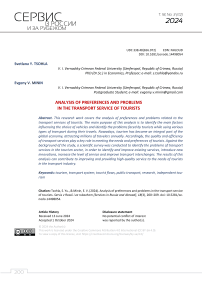Analysis of preferences and problems in the transport service of tourists
Автор: Tsohla S.Y., Minin E.V.
Журнал: Сервис в России и за рубежом @service-rusjournal
Рубрика: Социально-экономические аспекты развития отраслей, комплексов, предприятий и организаций сферы услуг
Статья в выпуске: 3 (112), 2024 года.
Бесплатный доступ
This research work covers the analysis of preferences and problems related to the transport services of tourists. The main purpose of this analysis is to identify the main factors influencing the choice of vehicles and identify the problems faced by tourists while using various types of transport during their travels. Nowadays, tourism has become an integral part of the global economy, attracting millions of travelers annually. Accordingly, the quality and efficiency of transport services play a key role in meeting the needs and preferences of tourists. Against the background of the study, a scientific survey was conducted to identify the problems of transport services in the tourism sector, in order to identify and improve existing services, introduce new innovations, increase the level of service and improve transport interchanges. The results of this analysis can contribute to improving and providing high-quality service to the needs of tourists in the transport industry.
Tourism, transport system, tourist flows, public transport, research, independent tourism
Короткий адрес: https://sciup.org/140307219
IDR: 140307219 | УДК: 338.48(656.072) | DOI: 10.5281/zenodo.14498054
Текст научной статьи Analysis of preferences and problems in the transport service of tourists
To view a copy of this license, visit
In the modern world, tourism and recreation occupy an important place in the economy and culture of many countries, providing unique opportunities for research, recreation and entertainment. The core of the successful development of these areas is innovative transport services that ensure comfort, accessibility, travel efficiency and safety. With the advent of new technologies and management approaches, the transport infrastructure is being transformed, adapting to the needs of modern tourists and vacationers. Most regions of Russia have high tourist and recreational potential, including unique recreational and natural resources, cultural and historical heritage sites of both national and global importance. At the same time, there are problems in them that prevent their full development, due to the low level of development of tourist infrastructure, including transport, unsatisfactory condition of vehicles and communications, low quality of transport services [6].
The contribution of public transport to the development of tourism in the region should encourage transport planners and academic researchers to study the needs of tourists more deeply in order to improve the provision of services, as well as develop marketing and management tools to more effectively promote the use of public transport [10]. The quality of service in public transport can be determined by a wide range of characteristics. These characteristics, in turn, can be determined based on models of stated preferences based on the hypothetical behavior of potential users of tourist transport services and identified preferences based on the actual use of public transport.
Research in the field of determining the most likely mode of transport used by tourists is presented in the articles of the following authors Llano С., Pardo J., Pérez-Balsalobre S., Pérez J «Es-timating multicountry tourism flows by transport mode» [5], Vafeiadis E., Elldér E., «Correlates of perceived accessibility across transport modes and trip purposes: Insights from a Swedish sur-vey» [8], Li L., Shalaby A., «Navigating the transit network: Understanding riders’ information seeking behavior using trip planning data» [4], Weimin Zhenga, Mengling Lia, Zhibin Linb, Yangyu Zhanga в работе «Leveraging tourist trajectory data for effective destination planning and management: A new heuristic approach» [9], Gutiérrez A., Domènech A., Zaragozí B., Miravet D. «Profiling tourists' use of public transport through smart travel card data» [3], Aravind A., Suvin P. Venthu-ruthiyil, Mishra S. «Equity and accessibility assessment of fixed route transit systems integrated with on-demand feeder services» [1].
The qualitative aspects of bus transportation are relatively unexplored in the literature, but Cartenì A., Henke I., Picone M. «The value of waiting spaces: Tourists’ willingness to pay for high-quality bus terminals» we conducted a quantitative analysis of the impact of the quality of the bus station on travelers [2].
The method of data mining was carried out in the work Yael R., Gal-Tzurb A., Rechavi A. «Iden-tifying attributes of public transport services for urban tourists: A data-mining method». The work is devoted to the quality of public transport services in urban tourist areas, in particular, clarifying the characteristics of the most important for tourists before their arrival at their destination. The four most important attributes of the provision of transport services were identified: ticket prices, accessibility, duration of the trip and availability of service (opening hours and frequency) [10].
Despite a large number of studies on travel preferences, there is a noticeable gap in the literature regarding the quantitative modeling of tourists' choice of travel to tourist regions.
Thus, in accordance with the global goals for the development of domestic tourism, the study is aimed at studying the choice of tourists' method of transportation to tourist destinations in the southern part of Russia. The purpose of the research is to determine the level of transport services in the tourism sector.
The objectives of the study include:
-
- Determining the preferred vacation region for tourists;
Уважаемый респондент!
Просим ответить на вопросы, которые задействованы в научном исследовании проблем транспортного обслуживания в туристской сфере
|
1 |
Регион проживания |
7 |
Планируете свой отдых за |
-год - полгода - месяц - спонтанно |
||
|
2 |
Пол |
8 |
8. При планировании отдыха приоритетным является вил транспорта |
- автомобильный - автобусшяй же лезнод орожны й
|
||
|
3 |
Возраст |
9 |
От дома до вокзала, станции, аэропорта я добираюсь на |
- троллейбусе
- аэроэкспрессе |
||
|
4 |
Получаемый доход |
10 |
Сколько ждете нужный транспорт |
- до 5 мин. - 5-10 мин. - 10-30 мни. - более 30 М1ш, |
||
|
5 |
С вой отдых проводите |
- за рубежом - в России |
11 |
Сколько времени занимает дорога до вокзала, станшш, аэропорта |
- доЗОмпн. - от 1 до 1,5 часа - более 2 часов |
|
|
6 |
В России предпочитаете отдых в регионе |
- Северо-Западном
- Северо-Кавказском
|
12 |
В последние годы стали путешествовать чаще по стране |
-Да - нет |
13 Какие неудобства испытываете в пользовании транспортом на отдыхе?
14 Что необходимо улучшить в транспортном обслуживании туристов?
15 Ваши предложения по улучшению транспортного обслуживания туристов
Fig. 1 – Questionnaire of the scientific research "Problems of transport services in the tourism sector" (In Russ.)
-
- Determining the priority mode of transport when planning a vacation;
-
- Assessment of the level of transport services during a tourist trip.
The results of the study will allow specialists in planning tourist routes to better understand the patterns of behavior of tourists in public transport and direct their work to improve the quality of services in transport services. The identification of problematic areas of transport services in the tourism sector will help to develop ways to level the shortcomings and direct the vector of work to the problems highlighted by the respondents.
The main part
In December 2023, a scientific study of residents of the Southern, Central and Northwestern
Federal Districts (hereinafter referred to as the Federal District) of the Russian Federation was conducted to determine the problems of transport services in the tourism sector.
The survey was conducted in an online format and sent to Internet users from whom a panel sample was formed. The questionnaire was posted on sites such as: Survio, Yandex View, Ан-кетки.ru, Vkontakte social page.
During the survey, a total of 506 tourists were interviewed, 419 of them from the Southern Federal District, 33 from the Central Federal District, 29 from the Northwestern Federal District, 12 from the Volga Region and 10 from the Siberian Federal District. Respondents were offered a questionnaire of 15 questions that can be divided into blocks: socio-economic portrait of a tourist, criteria for choosing a trip, criteria for a vehicle when traveling, personal opinion of respondents about transport services during the trip (Fig. 1).
Respondents of both sexes participated in the survey, 53% of women, 47% of men, the age category of respondents is from 18 to +55 years old, the majority of respondents are aged 41 to 54 years, in percentage their share is 38% of the total number of respondents. The analysis of the income of the respondents showed that the income is from 30 to 60 thousand rubles (62% of respondents), 26% of respondents receive income up to 30 thousand rubles.
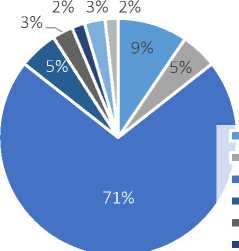
Central Federal District Northwest Federal District Southern Federal District
North Caucasian Federal District
Volga Federal District
Ural Federal District
Siberian Federal District Far Eastern Federal District
Fig. 2 – Respondents' preferred vacation regions in Russia
The portrait of our respondents looks like this: people of the average age category from 41 to 54 years old with an income level from 30 to 60 thousand rubles.
A scientific study showed that more than 90% of respondents prefer to spend their holidays within Russia, namely in the Southern Federal District (Fig. 2). Only 5% visited other countries. Such figures are not surprising, because 2023 in Russia became a record for domestic tourist flow, it amounted to 75 million people, thereby exceeding the indicator of 2022 by 9.5% 1.
The majority of respondents, judging by the results of the study, plan vacations spontaneously, 11% of respondents indicated that they start thinking about planning a vacation a month before the trip, 21% of tourists plan their vacation six months in advance and 18% start thinking about traveling a year in advance. It should be noted that the income of 62% of respondents is 30-60 thousand rubles. According to Rosstat, monetary incomes on average per capita in 2023 amounted to 50,265 thousand rubles per month [1]. According to the B1 study conducted in September 2022, the Russian consumer does not have the opportunity to plan their finances for a significant period of time [2]. In this regard, most residents of our country either do not have the opportunity to clearly build their budget, or I expect it for a period of no more than one month. Perhaps that is why, when asked about vacation planning, 50% of respondents indicated that this was a spontaneous decision (Fig. 3).
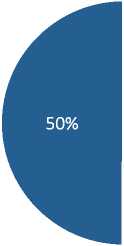
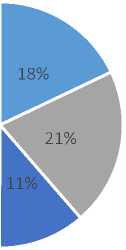
■ for the year
■ in six months
■ per month
■ spontaneously
Fig. 3 – Distribution of respondents by vacation planning time
It seems that transport behavior is largely due to the need to carry out any actions at the destination, which in itself affects the choice of a vehicle, the route of movement, and the permissible time spent. Thus, the study included questions regarding the preferred mode of transport, waiting time, as well as the implementation of time travel.
The tourists of the study like to relax in Russia, most indicated that they are happy to travel around the country. The most popular type of recreation in Russia was named by the survey participants as car travel around the country, 54%. we used the car to get to the place of rest. Aviation mode of transport was in second place, 16% of the respondents used it. The railway mode of transport took the third place, 15% chose it for transportation. 14% stated that they travel by bus, and 1% noted that they use a sea mode of transport (Fig. 4). The trend of auto travel began in 2022, when civil air traffic was blocked between the Southern Federal District. The growth of car travel has made it possible to give it the priority status of independent tourism, as well as to in- clude it in the national project "Tourism Hospitality Industry»2.
and the
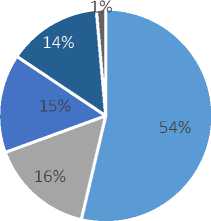
a car a plane a train a bus marine vessel
Fig. 4 – Distribution of respondents according to the choice of the priority mode of transport when planning a trip
At work Vafeiadis E., Elldér E. mention is made of a study conducted in the region of Gothenburg, Sweden, which assessed the perceived accessibility of a person to modes of transport. It is noteworthy that the presence of a car, a positive attitude towards this type of transport and frequent use of a car are associated with lower perceived accessibility of hiking, cycling and public transport, but higher perceived accessibility of a car. Tourists with young children may find slower modes of transport less accessible. People who frequently use a certain type of transport may be less aware of the availability of alternative modes. In general, the perception of accessibility is formed depending on various ways of foreseeing and types of tourist activities [4].
46% of respondents who travel by public means of transport, when specifying the waiting time for the arrival of a bus, trolleybus, taxi, metro to move to an airport, railway or bus station, indicated that they were waiting for the desired type of transport from 10 to 30 minutes (Fig. 5). This indicator is not the norm in relation to the total travel time which is less than 30 minutes in most cases.
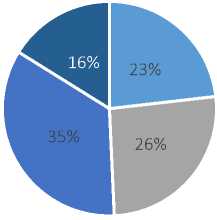
■ up to 5 minutes
■ 5-10 minutes
■ 10-30 minutes
■ more than 30 minutes
Fig. 5 – Distribution of respondents according to the choice of the priority mode of transport when planning a trip
One of the main criteria for choosing a vehicle is travel time. According to the majority of respondents, namely 63%, their journey from home to the train station, the station, the airport is up to 30 minutes (Fig. 6).
Based on the results indicated above, it can be assumed that the Russian tourism business has discovered a new direction of independent tourism – automobile. Now special attention is being paid to the development of tourism in the regions. Many of them are famous for their
2 The national project "Tourism and the hospitality industry". Ministry of Economic Development of the Russian Federation.
URL:
-------------------------------------------------------------------------------1 205
centuries-old history and unique natural conditions and, thanks to this, have powerful tourist potential. Among our respondents, the majority have long tried on the role of an exclusively tourist of Russian attractions, natural and historical, because 78% of respondents in recent years have not noticed that they have begun to travel more often around the country, nevertheless 22% of tourists are confident that in recent years they have seen how big Russia is.
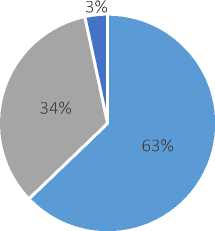
■ up to 30 minutes
■ from 1 to 1.5 hours
■ more than 2 hours
Fig. 6 – The predominant travel time for respondents from home, to the train station, the station, the airport
At the end of the questionnaire, the respondents were asked questions, the answers to which were not fixed. Open-ended questions assume that the respondent freely expresses his thoughts on the subject of the question. In accordance with the fact that the three open questions were related to the use of public vehicles when traveling on vacation, we highlight that with a difference of 1,2% of respondents use air, rail and buses, in this sequence, and tourists get to the airport by bus.
Considering the issues of using public transport while already on vacation, it should be borne in mind that we are talking about unearthly modes of transport. Due to the fact that motorists are breaking records, the responses of motorists are also taken into account in the analysis.
Respondents experience inconveniences in using transport on vacation due to an incorrectly arranged schedule. There may be disruptions in the timetable for various reasons: breakdowns and accidents, traffic disruptions due to congestion and traffic jams, unauthorized departure from the flight / flight cancellation. Non-compliance with the schedule creates huge inconveniences for tourists, it can be burnt tickets for an excursion or a missed place on the beach. Since passengers are not sure about the availability of flights at the required time, they are not sure about observing a certain interval in the schedule, passengers are redistributed to other time intervals, as a result of which the transport may be overcrowded. Crowded transport affects one of the following important criteria for the inconvenience of using transport on vacation – the lack of comfortable conditions when traveling. An incorrectly arranged schedule also affects the fact that passengers transfer to other vehicles, for example: taxi, private transport. The choice of alternative vehicles also affects the second most important indicator of tourist inconveniences – traffic congestion (Fig. 7).
Poor logistics, the same type of route network
Lack of information about the route, transport schedule, type of travel documents
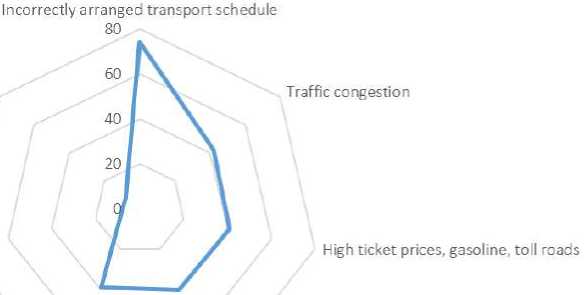
T , Lack of comfortable conditions during
Transport infrastructure . .
the trip
Fig. 7 – Inconveniences of tourists in using transport on vacation
The respondents of the scientific research answered the questions as openly as possible and shared their opinions. Some of the answers include a number of points that are worth paying attention to in further analysis.
In such criteria as the lack of comfortable conditions during the trip, respondents pointed out a number of disadvantages:
-
- Lack of air conditioning/heating systems;
-
- Lack of Wi-Fi;
-
- Poor transport condition;
-
- An uncomfortable payment method, it is not possible to pay with a card everywhere;
-
- Lack of equipped places for parents with children;
-
- There is no single transport card by type of transport operating throughout Russia.
By transport infrastructure, the respondents meant the following inconveniences:
-
- Lack of parking spaces at train stations;
-
- Lack of bus stations;
-
- Lack of information signs on the route;
-
- The lack of a sufficient number of gas stations on the route;
-
- Poor-quality road surface;
-
- The absence of tourist car routes in mountainous areas or to unusual / interesting vacation spots.
Despite the fact that respondents are primarily concerned about the schedule, on the issue of improving transport services, the majority of respondents speak in the direction of improving the quality of service (Fig. 8).
The quality of service is:
-
- Timely cleaning;
-
- Installation of an air conditioner and repair of a heating system;
-
- Develop a standard transport map for the whole country;
-
- Arrange places for families with children, passengers with luggage;
-
- Improve waiting areas.
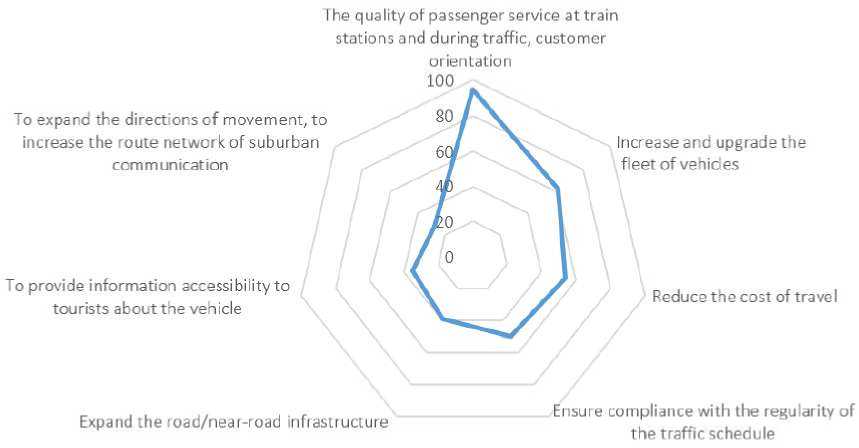
Fig. 8 – Suggestions for improving transport services in tourism
While observing the regularity of traffic, focus on seasonality, holidays and an increase in passenger traffic, increase the number of flights in the schedule, increase the working hours of public transport.
Under improvements to the road/near-road infrastructure, motorists were responsible for creating recreation areas and increasing free parking spaces.
-
- Ensuring the information accessibility of tourists is also one of the main criteria for improving transport services for tourists:
-
- Schedule available to tourists;
-
- Availability of information about the sights;
-
- Information about the route;
-
- Develop applications for using public
СЕРВИС
В РОССИИ
И ЗА РУБЕЖОМ transport;
-
- To organize a single booking system so that it is comfortable to transfer from an airplane to a train, for example;
-
- Create a unified network of schedules for different types of transport, so that they relate to each other and there is no situation when the bus left five minutes before the arrival of the train and so on.
In the final question of the questionnaire, respondents had to write suggestions for improving transport services (Fig. 9):
-
- Creation of applications for route tracking and passenger information;
-
- Implementation of intelligent transport systems;
-
- Introduction of preferential "Doctor on board" type programs in all types of transport;
-
- Free tickets for privileged categories of citizens;
-
- Arrange places for strollers;
-
- Create a unified ticket booking system.
By high-quality and comfortable vehicles, we meant:
-
- Expansion of seats;
-
- Comfort of waiting areas at train stations;
-
- Replacement of the fleet of intercity carriers. Respondents propose to improve the public transport system as follows:
-
- Adding new routes;
-
- Review and improve the logistics of public transport in connection with the expansion of tourist destinations;
-
- The development of transport infrastructure should be aimed at:
-
- Allocation of lanes for public transport in the general flow;
-
- Development of recreation infrastructure along the main directions;
-
- Organization of tourist maps for travel to attractions.
Improve security
To develop the transport infrastructure
To improve the quality of service, service
Strengthen the control of the relevant services
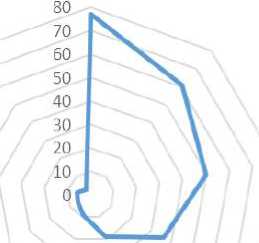
Proper scheduling
High-quality and comfortable vehicles
Improve pricing policy
To provide information accessibility to tourists
To improve the public transport syste m
Fig. 9 – Suggestions for improving transport services in tourism
Conclusion
The results of the analysis allow us to come to the following conclusions, the respondents of the study spend their holidays in Russia, namely in the Southern Federal District, rest in the chapels of Russia is the norm for our respondents, because they have not begun to travel more often around the country in recent years. They plan their vacation spontaneously, when planning a vacation, the priority mode of transport is automobile. From home, to the train station, the station, the airport, they get by private car. Respondents using public transport expect it from 10 to 30 minutes, despite the fact that it takes up to 30 minutes to get to the train station, station or airport.
The improperly washed public transport schedule is very disturbing for tourists of the southern Federal District. One of the proposals to improve the timetable situation was to create a unified network of timetables for different modes of transport with the possibility of correlation between each other. It is necessary to improve transport services in terms of customer orientation. The improvement proposals are aimed at providing information support to passengers through the introduction of intelligent systems, such as booking systems and application development.
The change in the tourism management system is aimed at continuous improvement of economic support measures for the integrated development of tourism. Within the framework of the federal project "Development of tourist infrastructure", tourist information centers were equipped, modern campsites and modular hotels were built for motorists, and various travel guide applications were developed.
The implementation of some of the respondents' proposals is already going through the stages of creation and commissioning. The state's support for domestic tourism will improve the tourist service and make vacation spots and tourist routes more interesting, diverse and accessible.
Список литературы Analysis of preferences and problems in the transport service of tourists
- Aravind, A., Suvin, P. V., & Mishra, S. (2024). Equity and accessibility assessment of fixed route transit systems integrated with on-demand feeder services. Journal of Transport Geography, 121, 104028. doi: 10.1016/j.jtrangeo.2024.104028.
- Cartenì, A., Henke, I., & Picone, M. (2024). The value of waiting spaces: Tourists’ willingness to pay for high-quality bus terminals. Transportation Research Interdisciplinary Perspectives, 26, 101129. doi: 10.1016/j.trip.2024.101129.
- Gutiérrez, A., Domènech, A., Zaragozí, B., & Miravet, D. (2020). Profiling tourists' use of public transport through smart travel card data. Journal of Transport Geography, 88, 102820. doi: 10.1016/j.jtrangeo.2020.102820.
- Li, L., & Shalaby, A. (2024). Navigating the transit network: Understanding riders’ information seeking behavior using trip planning data. Transportation Research Part A: Policy and Practice, 185, 104096. doi: 10.1016/j.tra.2024.104096.
- Llano, C., Pardo, J., Pérez-Balsalobre, S., & Pérez, J. (2023). Estimating multicountry tourism flows by transport mode. Annals of Tourism Research, 103, 103672. doi: 10.1016/j.annals.2023.103672.
- Safina, N. F. (2023). Sovremennoye sostoyaniye i perspektivy razvitiya vnutrennego turizma v Rossiyskoy Federatsii [The current state and prospects for the development of domestic tourism in the Russian Federation]. Russkiy zhurnal menedzhmenta [Russian Journal of Management], 3, 214-223. doi: 10.29039/2409-6024-2023-11-3-214-223. (In Russ).
- Shipulin, H. V., & Shibaeva, N. A. (2018). Sovremennoye sostoyaniye turistskoy transportnoy sistemy Rossii i perspektivy yeyo razvitiya [The current state of the Russian tourist transport system and prospects for its development]. Strategiya razvitiya industrii gostepriimstva i turizma [Strategy for the development of the hospitality and tourism industry]: Proceedings of the VII International Internet Conference. Orel: Turgenev Orel State University, 409-412. (In Russ).
- Vafeiadis, E., & Elldér, E. (2024). Correlates of perceived accessibility across transport modes and trip purposes: Insights from a Swedish survey. Transportation Research Part A: Policy and Practice, 186, 104147. doi: 10.1016/j.tra.2024.104147.
- Weimin, Z., Mengling, L., Zhibin, L., & Yangyu, Z. (2022). Leveraging tourist trajectory data for effective destination planning and management: A new heuristic approach. Tourism Management, 89, 104437. doi: 10.1016/j.tourman.2021.104437.
- Yael, R., Gal-Tzur, A., & Rechavi, A. (2021). Identifying attributes of public transport services for urban tourists: A data-mining method. Journal of Transport Geography, 93, 103069. doi: 10.1016/j.jtrangeo.2021.103069.

